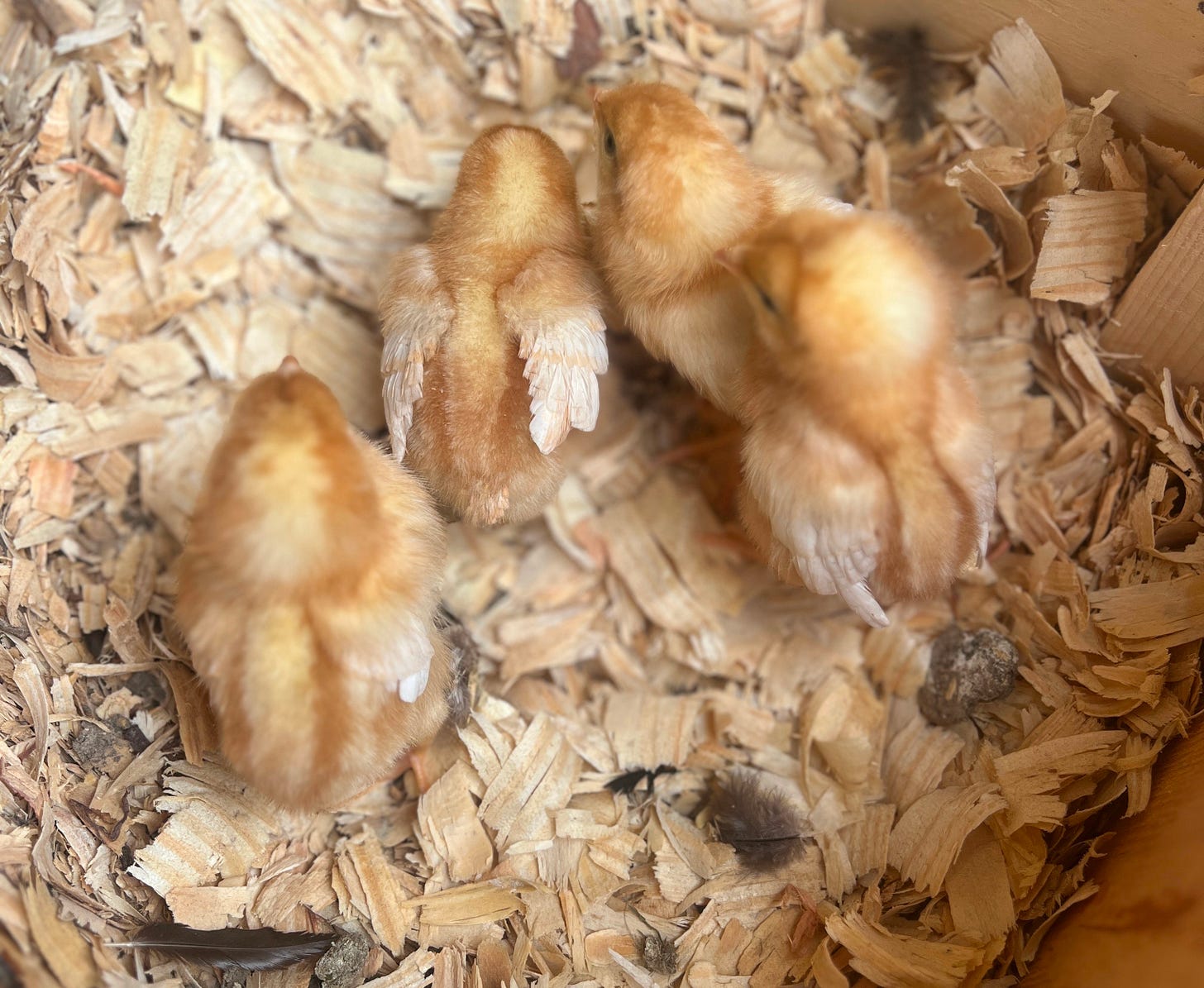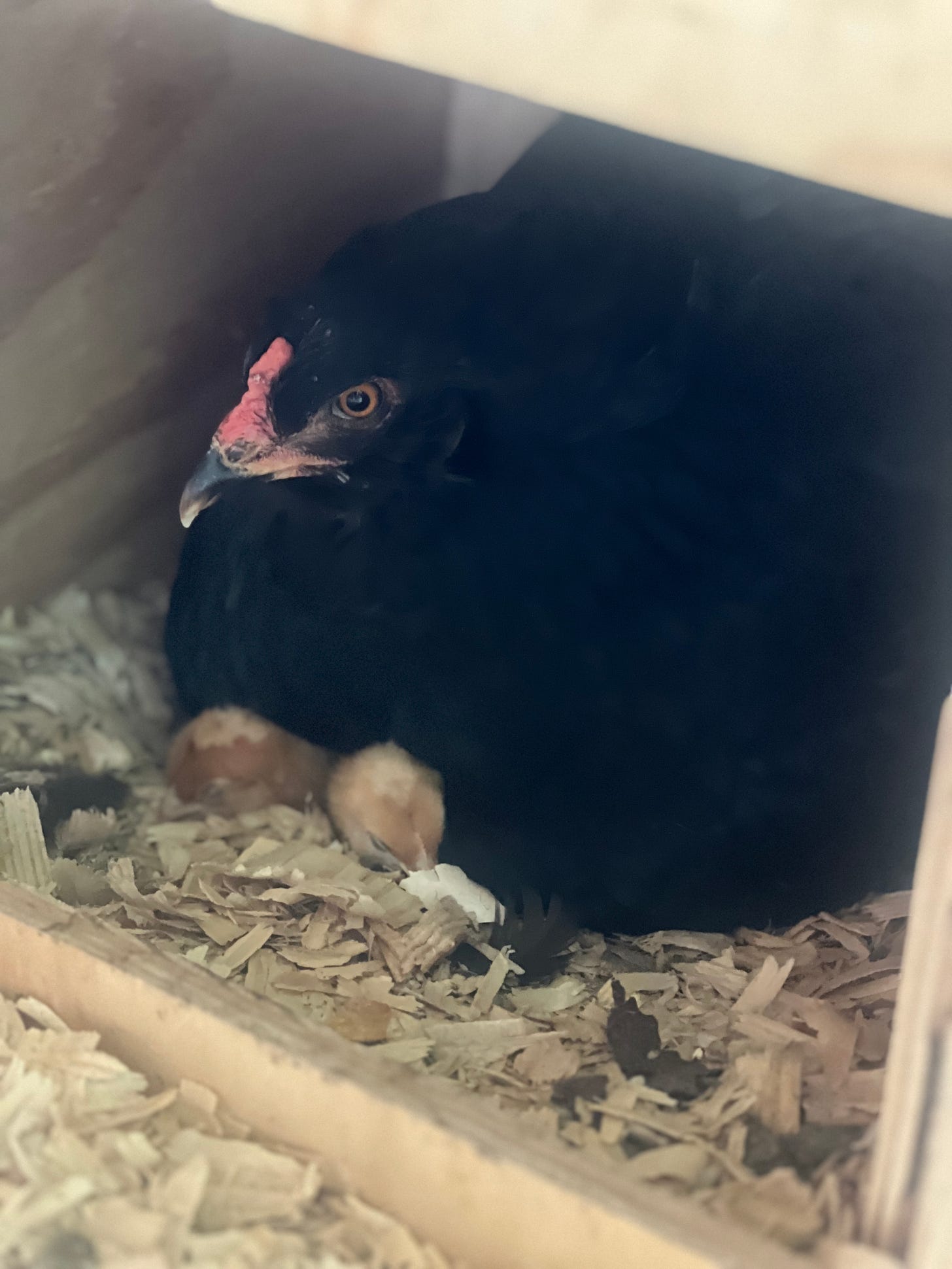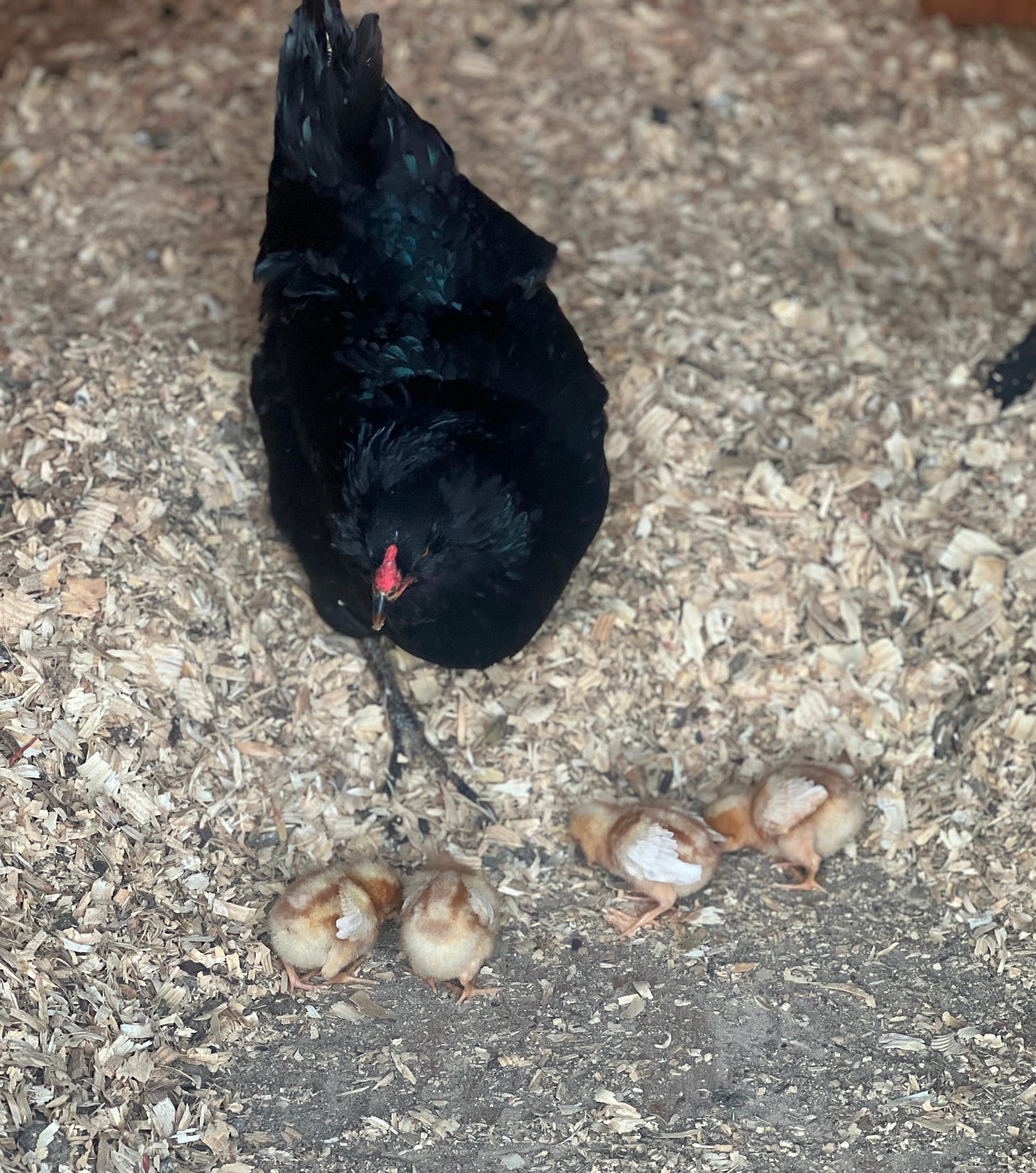Sometimes we choose the wrong risk. But we have to keep choosing anyway.
A (sad but also happy) chicken update
Remember last week, when I posted a happy-and-hopeful story about the one-and-only chick my broody hen had to show for three long weeks of sitting on eggs?
Well, on Monday, that little saga took another sad twist.
All the chickens had been cohabitating in the same coop for a few days by that point, separated by a wall of chicken wire. But Mama was ready to start teaching the new baby how to do allllll the chicken things, and the two of them were a little cramped in the small area we’d cordoned off for them.
I briefly considered closing off the coop entirely and letting the adult chickens roost in the covered run for a while so that Mama and baby could have more privacy and room to roam…but we’d been seeing a lot of evidence of predators lurking around the run, so that wasn’t without risks either.
There was also the chance that the chickens would refuse to come into the enclosed area at night since they were locked out of the coop, and would instead roost in the trees - also a vulnerable place for them to be.
So, I decided to take down the wall and integrate all the chickens together.
On Monday morning I went down to the coop and everything looked well. Mom and baby were cuddled up in their nesting box, and there were three other hens in the coop - two of them jammed into a single nesting box (why do they do that?!) and the other sitting in the corner. Everything seemed peaceful, and feeling confident that all was well, I headed back up to the house.
I was doing the dishes just ten or fifteen minutes later when I heard a ruckus down in the coop—including frantic cheeping from the chick. By the time I ran down the hill to see what was happening, it was too late: the baby was dead, killed by one of the other chickens. (I’m not sure which one - I don’t think the rooster was in the coop at the time, and I strongly suspect it was one of the nesting-box hens who felt put out at this new intruder, but there’s no real way to know.)
Maybe if I weren’t still a beginner at this, I’d have chosen differently. But maybe not. I’d known something like this could happen, after all, and often managing the different contingencies in all those “coulds” can feel like a game of risk-management whack-a-mole. But what I “should have” done aside, my choice had a very sad consequence, and I felt just sick about it.
An hour or so later I went back down to check on the poor mama hen, who was running in circles inside the coop, looking confused and stressed. While hens might not grasp the loss of a chick in the same way humans would, this mama chicken knew she was supposed to be doing something, and that she was supposed to have someone to care for. And now that someone was gone. She didn’t know what to do about it, and neither did I.
That’s when Eric made a suggestion I can’t believe I didn’t come up with first: why not run to Tractor Supply, buy a few more chicks, and see if they’d all take to each other? If they didn’t bond, I could always brood them inside like I’ve done before.
I was running to the car, purse over my shoulder, practically before he finished his thought; and within fifteen minutes I was back with four Isa Brown chicks, the youngest they had at the store.
Again, this maneuver could prove to be a bit risky. There are all kinds of reasons a bereaved mother hen might not take to newcomers. She could wind up being violent with them, though I doubted it; she’d been very gentle and docile with her chick, and while she’d been protective while brooding her eggs, she’d never followed through on all her vocal bluster with anything more than a gentle warning peck.
Another risk is that the babies may not bond to the hen. This was a real possibility, as these chicks were probably at least four or five days old by this time.
But in the moment, I wanted to do something to relieve the chicken’s stress and give her a chance at acting on her mama-hen instincts. Now, all I could do was introduce the hen and chicks carefully to one another, watch, and hope it all went well.
I was right to guess that mama hen was still interested in being a mother. The minute she heard the chicks peeping, she started clucking and purring and looking all over the place for these mystery babies.
I wish I had a picture of mama hen’s face as the chicks tumbled out of the box and started running around the inside of the (now closed) coop. Her surprised expression seemed to say, “Wait, didn’t I just have one baby before? How are there four now? And why are they….that color?”
She pulled herself together pretty quickly and started doing all the same things she’d done with her biological baby: cooing and clucking, pecking at the ground and waiting for them to follow suit, and even letting out a loud warning once when I moved my arm too fast.
It took the babies a bit longer to get with the program, however. They were intrigued by this large new roommate who seemed to know how to do all kinds of interesting things, but they were also so distracted by the new space that they ran around in circles around her instead of taking time to bond.
The real test, I figured, would be when the chicks started to get chilled. I’d have to keep an eye to make sure the babies went to the mama hen to warm up and that she’d agree to cuddle them, since they wouldn’t have any other source of heat in the coop.
Once I was satisfied that nobody was going to get hurt, I decided to leave them all alone for a while to settle in together.
And when I came back an hour later, this is what I found.
Success!
It’s basically just gotten cuter from there. When I went down to the coop yesterday morning, I found that mama hen had scratched up a huge bare area on the coop floor and turned it into a classroom - and her four adopted babies seem to be the world’s most attentive pupils.
The other chickens are, for now, locked out of the coop, and for the last two nights they’ve (with some confusion) made their way into the covered run where they all pile on top of each other instead of using the roosting bar Eric built for them. Their choice, I suppose. You can lead a chicken to a normal situation, but you can’t make it not be weird.
Since our outdoor run is actually two large dog kennels attached by a gate, my plan is to keep the gate closed for a while, let most of the flock hang out in one half and give mama and baby free run of the coop and the other half, while they all get used to one another and the babies learn some self-defense skills. I can’t be sure it’ll work, but I’m hopeful.
I learned some things from this experience.
Number one, sometimes you make a call in the moment, using your clearest judgment and the best information you have available at the time…and it still turns out to be the wrong call. In animal husbandry (as in motherhood and all kinds of human relationships), those kinds of choices can unfortunately have severe consequences. But not choosing isn’t an option, either. We do what we can and we try to forgive ourselves when it goes wrong.
(By the way, I wrote quite a lot about both facing and addressing regret and tending chickens in The Last Parenting Book You’ll Ever Read.)
And number two: when faced with a setback, there is always something we can do. Getting too caught up in whether it’s the exact right thing isn’t always helpful. There is never zero risk; there are just the risks we choose, and how we handle the consequences.
The four adoptive chicks won’t bring back the ones that my mama hen lost, and my goodness, she’s had a rough and bumpy road to motherhood, but she still keeps showing up for the job and so can I: learning from my mistakes, adjusting the plan as needed, and making amends whenever I can.
Including, when needed, a last-minute run to the farm store to unite a very eager mama hen in need of a chick to mother with her new little adopted family.
recommended reading
wrote a lovely post about tapping into beginner energy the other day including more adorable chicken pictures, encouragement for writers, and a generous recommendation of my podcast and writing! April’s also just published a book, Subtle Resistance, that is right in-line with the heart of The Kettle, and I think you might love it.
Check out April’s Substack, Embracing Home.
And don’t forget - tonight at 7:30 PM EST, we’re having our first PJ Chat for paying members of The Kettle Community. Bring your favorite evening beverage and come as you are for a cozy and casual chat. Find the link in our chat (if you’re a paying member, you’ll also find the link in the June Journal post from June 1.)
As always, I love hearing from you. Leave a comment or hit “reply” to answer via email.










I am so glad that your broody momma hen adopted the new chicks. So sad! I love how you embrace learning curves in so many areas of your life, and you share the journey with us all. And thank you for your kind comments on my book and post! 💙
This is absolutely beautiful. And this -"You can lead a chicken to a normal situation, but you can’t make it not be weird." - kinda seems to sum up parenting teens too. 😀